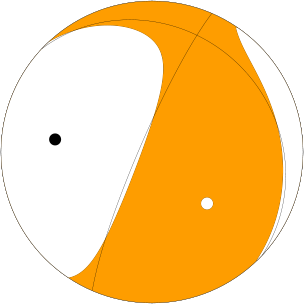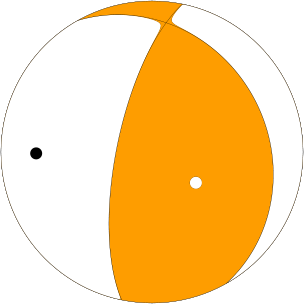Location
2014/04/11 00:01:44 -20.748 -70.724 17.5 6.0 Chile
Arrival Times (from USGS)
Arrival time list
Felt Map
USGS Felt map for this earthquake
USGS Felt reports main page
Focal Mechanism
USGS/SLU Moment Tensor Solution
ENS 2014/04/11 00:01:44:0 -20.75 -70.72 17.5 6.0 Chile
Stations used:
C.GO01 C.GO02 CX.MNMCX CX.PATCX CX.PB01 CX.PB04 CX.PB06
CX.PB07 CX.PB08 CX.PB09 CX.PB10 CX.PB11 CX.PB12 CX.PB14
CX.PB15 CX.PB16 CX.PSGCX GT.LPAZ
Filtering commands used:
cut a -30 a 180
rtr
taper w 0.1
hp c 0.02 n 3
lp c 0.06 n 3
Best Fitting Double Couple
Mo = 1.17e+25 dyne-cm
Mw = 5.98
Z = 20 km
Plane Strike Dip Rake
NP1 198 76 111
NP2 320 25 35
Principal Axes:
Axis Value Plunge Azimuth
T 1.17e+25 54 133
N 0.00e+00 20 12
P -1.17e+25 28 271
Moment Tensor: (dyne-cm)
Component Value
Mxx 1.87e+24
Mxy -1.84e+24
Mxz -3.90e+24
Myy -7.03e+24
Myz 8.92e+24
Mzz 5.16e+24
#############-
##---------####-------
-----------------##---------
-----------------######-------
------------------#########-------
------------------############------
------------------##############------
-------------------################-----
------------------#################-----
---- -----------###################-----
---- P -----------####################----
---- ----------#####################----
----------------######################----
---------------########## #########---
---------------########## T #########---
-------------########### #########--
------------######################--
-----------######################-
---------#####################
-------####################-
----##################
-#############
Global CMT Convention Moment Tensor:
R T P
5.16e+24 -3.90e+24 -8.92e+24
-3.90e+24 1.87e+24 1.84e+24
-8.92e+24 1.84e+24 -7.03e+24
Details of the solution is found at
http://www.eas.slu.edu/eqc/eqc_mt/MECH.NA/20140411000144/index.html
|
Preferred Solution
The preferred solution from an analysis of the surface-wave spectral amplitude radiation pattern, waveform inversion and first motion observations is
STK = 320
DIP = 25
RAKE = 35
MW = 5.98
HS = 20.0
The NDK file is 20140411000144.ndk
The waveform inversion is preferred.
Moment Tensor Comparison
The following compares this source inversion to others
| SLU |
USGSMT |
|
GCMT |
USGSW |
|
USGS/SLU Moment Tensor Solution
ENS 2014/04/11 00:01:44:0 -20.75 -70.72 17.5 6.0 Chile
Stations used:
C.GO01 C.GO02 CX.MNMCX CX.PATCX CX.PB01 CX.PB04 CX.PB06
CX.PB07 CX.PB08 CX.PB09 CX.PB10 CX.PB11 CX.PB12 CX.PB14
CX.PB15 CX.PB16 CX.PSGCX GT.LPAZ
Filtering commands used:
cut a -30 a 180
rtr
taper w 0.1
hp c 0.02 n 3
lp c 0.06 n 3
Best Fitting Double Couple
Mo = 1.17e+25 dyne-cm
Mw = 5.98
Z = 20 km
Plane Strike Dip Rake
NP1 198 76 111
NP2 320 25 35
Principal Axes:
Axis Value Plunge Azimuth
T 1.17e+25 54 133
N 0.00e+00 20 12
P -1.17e+25 28 271
Moment Tensor: (dyne-cm)
Component Value
Mxx 1.87e+24
Mxy -1.84e+24
Mxz -3.90e+24
Myy -7.03e+24
Myz 8.92e+24
Mzz 5.16e+24
#############-
##---------####-------
-----------------##---------
-----------------######-------
------------------#########-------
------------------############------
------------------##############------
-------------------################-----
------------------#################-----
---- -----------###################-----
---- P -----------####################----
---- ----------#####################----
----------------######################----
---------------########## #########---
---------------########## T #########---
-------------########### #########--
------------######################--
-----------######################-
---------#####################
-------####################-
----##################
-#############
Global CMT Convention Moment Tensor:
R T P
5.16e+24 -3.90e+24 -8.92e+24
-3.90e+24 1.87e+24 1.84e+24
-8.92e+24 1.84e+24 -7.03e+24
Details of the solution is found at
http://www.eas.slu.edu/eqc/eqc_mt/MECH.NA/20140411000144/index.html
|
Regional Moment Tensor (Mwr)
Moment magnitude derived from a moment tensor
inversion of complete waveforms at regional
distances (less than ~8 degrees), generally
used for the analysis of small to moderate
size earthquakes (typically Mw 3.5-6.0)
crust or upper mantle earthquakes.
Moment
1.25e+18 N-m
Magnitude
6.0
Percent DC
67%
Depth
15.0 km
Updated
2014-04-11 00:30:23 UTC
Author
us
Catalog
us
Contributor
us
Code
us_c000pfgr_mwr
Principal Axes
Axis Value Plunge Azimuth
T 1.147 49 133
N 0.186 18 21
P -1.333 36 277
Nodal Planes
Plane Strike Dip Rake
NP1 203° 83 108
NP2 313° 20 21
|

|
April 11, 2014, NEAR COAST OF NORTHERN CHILE, MW=6.2
Howard Koss
CENTROID-MOMENT-TENSOR SOLUTION
GCMT EVENT: C201404110001A
DATA: II MN LD G GE DK KP
L.P.BODY WAVES: 74S, 142C, T= 40
MANTLE WAVES: 53S, 73C, T=125
SURFACE WAVES: 93S, 206C, T= 50
TIMESTAMP: Q-20140411034219
CENTROID LOCATION:
ORIGIN TIME: 00:01:51.3 0.1
LAT:20.59S 0.01;LON: 70.90W 0.01
DEP: 15.4 0.5;TRIANG HDUR: 3.0
MOMENT TENSOR: SCALE 10**25 D-CM
RR= 0.981 0.018; TT= 0.337 0.012
PP=-1.320 0.017; RT=-0.591 0.055
RP=-2.070 0.096; TP= 0.165 0.010
PRINCIPAL AXES:
1.(T) VAL= 2.372;PLG=56;AZM=120
2.(N) 0.173; 12; 11
3.(P) -2.547; 31; 274
BEST DBLE.COUPLE:M0= 2.46*10**25
NP1: STRIKE=329;DIP=18;SLIP= 47
NP2: STRIKE=194;DIP=77;SLIP= 103
#########--
------------##-----
-------------######----
--------------#########----
--------------###########----
---------------#############---
--------------##############---
---- -------################---
---- P -------################---
---- -------####### #######--
-------------######## T #######--
------------######## ######--
------------#################--
----------#################--
---------################--
-------###############-
-----#############-
-##########
|
W-phase Moment Tensor (Mww)
Moment magnitude derived from a centroid moment
tensor inversion of the W-phase, a very long
period phase (~100 - 1000 s) arriving at the
same time as the P-wave. W-phase solutions can
be computed at both regional (~5 to ~20 degrees)
and teleseismic (~30 to ~90 degrees) distances.
Moment
1.46e+18 N-m
Magnitude
6.0
Percent DC
99%
Depth
23.5 km
Updated
2014-04-11 07:28:38 UTC
Author
us
Catalog
us
Contributor
us
Code
usc000pfgr
Principal Axes
Axis Value Plunge Azimuth
T 1.457 61 125
N 0.003 15 6
P -1.461 24 269
Nodal Planes
Plane Strike Dip Rake
NP1 192 71 106
NP2 331 25 52
|

|
Waveform Inversion
The focal mechanism was determined using broadband seismic waveforms. The location of the event and the
and stations used for the waveform inversion are shown in the next figure.

|
|
Location of broadband stations used for waveform inversion
|
The program wvfgrd96 was used with good traces observed at short distance to determine the focal mechanism, depth and seismic moment. This technique requires a high quality signal and well determined velocity model for the Green functions. To the extent that these are the quality data, this type of mechanism should be preferred over the radiation pattern technique which requires the separate step of defining the pressure and tension quadrants and the correct strike.
The observed and predicted traces are filtered using the following gsac commands:
cut a -30 a 180
rtr
taper w 0.1
hp c 0.02 n 3
lp c 0.06 n 3
The results of this grid search from 0.5 to 19 km depth are as follow:
DEPTH STK DIP RAKE MW FIT
WVFGRD96 2.0 200 40 90 5.74 0.4259
WVFGRD96 4.0 305 15 15 5.82 0.3597
WVFGRD96 6.0 300 15 15 5.84 0.5311
WVFGRD96 8.0 305 10 20 5.92 0.6339
WVFGRD96 10.0 315 15 30 5.92 0.7300
WVFGRD96 12.0 320 20 35 5.94 0.7949
WVFGRD96 14.0 325 20 40 5.95 0.8376
WVFGRD96 16.0 325 25 40 5.96 0.8634
WVFGRD96 18.0 320 25 35 5.97 0.8749
WVFGRD96 20.0 320 25 35 5.98 0.8755
WVFGRD96 22.0 320 25 35 6.00 0.8684
WVFGRD96 24.0 315 25 30 6.02 0.8549
WVFGRD96 26.0 315 25 30 6.03 0.8366
WVFGRD96 28.0 310 25 25 6.04 0.8138
WVFGRD96 30.0 310 25 25 6.05 0.7875
WVFGRD96 32.0 310 25 25 6.06 0.7574
WVFGRD96 34.0 310 25 25 6.07 0.7255
WVFGRD96 36.0 305 25 20 6.07 0.6926
WVFGRD96 38.0 305 25 20 6.07 0.6618
WVFGRD96 40.0 305 20 20 6.21 0.6364
WVFGRD96 42.0 305 20 20 6.22 0.6036
WVFGRD96 44.0 305 20 20 6.22 0.5703
WVFGRD96 46.0 300 20 15 6.23 0.5380
WVFGRD96 48.0 295 25 5 6.23 0.5078
WVFGRD96 50.0 295 25 5 6.24 0.4793
WVFGRD96 52.0 290 25 0 6.24 0.4521
WVFGRD96 54.0 290 25 0 6.24 0.4273
WVFGRD96 56.0 285 25 -5 6.24 0.4046
WVFGRD96 58.0 280 25 -15 6.24 0.3858
WVFGRD96 60.0 275 25 -25 6.25 0.3717
WVFGRD96 62.0 275 30 -30 6.25 0.3608
WVFGRD96 64.0 265 30 -45 6.25 0.3529
WVFGRD96 66.0 260 30 -50 6.26 0.3498
WVFGRD96 68.0 265 35 -50 6.26 0.3486
WVFGRD96 70.0 260 35 -55 6.27 0.3501
WVFGRD96 72.0 220 35 -75 6.27 0.3523
WVFGRD96 74.0 220 35 -75 6.28 0.3601
WVFGRD96 76.0 220 35 -75 6.29 0.3675
WVFGRD96 78.0 220 35 -75 6.29 0.3713
WVFGRD96 80.0 220 35 -75 6.30 0.3777
WVFGRD96 82.0 215 35 -80 6.31 0.3797
WVFGRD96 84.0 215 35 -80 6.31 0.3842
WVFGRD96 86.0 215 35 -80 6.32 0.3903
WVFGRD96 88.0 215 35 -80 6.32 0.3915
WVFGRD96 90.0 220 40 -80 6.32 0.3953
WVFGRD96 92.0 215 40 -80 6.33 0.3986
WVFGRD96 94.0 215 40 -80 6.33 0.4000
WVFGRD96 96.0 10 50 -80 6.33 0.4026
WVFGRD96 98.0 10 50 -80 6.33 0.4039
WVFGRD96 100.0 10 50 -80 6.34 0.4065
WVFGRD96 102.0 10 50 -80 6.34 0.4085
WVFGRD96 104.0 10 50 -80 6.34 0.4081
WVFGRD96 106.0 10 50 -80 6.35 0.4100
WVFGRD96 108.0 10 50 -80 6.35 0.4086
The best solution is
WVFGRD96 20.0 320 25 35 5.98 0.8755
The mechanism correspond to the best fit is

|
|
Figure 1. Waveform inversion focal mechanism
|
The best fit as a function of depth is given in the following figure:

|
|
Figure 2. Depth sensitivity for waveform mechanism
|
The comparison of the observed and predicted waveforms is given in the next figure. The red traces are the observed and the blue are the predicted.
Each observed-predicted component is plotted to the same scale and peak amplitudes are indicated by the numbers to the left of each trace. A pair of numbers is given in black at the right of each predicted traces. The upper number it the time shift required for maximum correlation between the observed and predicted traces. This time shift is required because the synthetics are not computed at exactly the same distance as the observed and because the velocity model used in the predictions may not be perfect.
A positive time shift indicates that the prediction is too fast and should be delayed to match the observed trace (shift to the right in this figure). A negative value indicates that the prediction is too slow. The lower number gives the percentage of variance reduction to characterize the individual goodness of fit (100% indicates a perfect fit).
The bandpass filter used in the processing and for the display was
cut a -30 a 180
rtr
taper w 0.1
hp c 0.02 n 3
lp c 0.06 n 3

|
|
Figure 3. Waveform comparison for selected depth. Red: observed; Blue - predicted. The time shift with respect to the model prediction is indicated. The percent of fit is also indicated.
|

|
|
Focal mechanism sensitivity at the preferred depth. The red color indicates a very good fit to thewavefroms.
Each solution is plotted as a vector at a given value of strike and dip with the angle of the vector representing the rake angle, measured, with respect to the upward vertical (N) in the figure.
|
A check on the assumed source location is possible by looking at the time shifts between the observed and predicted traces. The time shifts for waveform matching arise for several reasons:
- The origin time and epicentral distance are incorrect
- The velocity model used for the inversion is incorrect
- The velocity model used to define the P-arrival time is not the
same as the velocity model used for the waveform inversion
(assuming that the initial trace alignment is based on the
P arrival time)
Assuming only a mislocation, the time shifts are fit to a functional form:
Time_shift = A + B cos Azimuth + C Sin Azimuth
The time shifts for this inversion lead to the next figure:

The derived shift in origin time and epicentral coordinates are given at the bottom of the figure.
Discussion
Acknowledgements
Thanks also to the many seismic network operators whose dedication make this effort possible: University of Nevada Reno, University of Alaska, University of Washington, Oregon State University, University of Utah, Montana Bureas of Mines, UC Berkely, Caltech, UC San Diego, Saint Louis University, University of Memphis, Lamont Doherty Earth Observatory, the Iris stations and the Transportable Array of EarthScope.
Velocity Model
The WUS used for the waveform synthetic seismograms and for the surface wave eigenfunctions and dispersion is as follows:
MODEL.01
Model after 8 iterations
ISOTROPIC
KGS
FLAT EARTH
1-D
CONSTANT VELOCITY
LINE08
LINE09
LINE10
LINE11
H(KM) VP(KM/S) VS(KM/S) RHO(GM/CC) QP QS ETAP ETAS FREFP FREFS
1.9000 3.4065 2.0089 2.2150 0.302E-02 0.679E-02 0.00 0.00 1.00 1.00
6.1000 5.5445 3.2953 2.6089 0.349E-02 0.784E-02 0.00 0.00 1.00 1.00
13.0000 6.2708 3.7396 2.7812 0.212E-02 0.476E-02 0.00 0.00 1.00 1.00
19.0000 6.4075 3.7680 2.8223 0.111E-02 0.249E-02 0.00 0.00 1.00 1.00
0.0000 7.9000 4.6200 3.2760 0.164E-10 0.370E-10 0.00 0.00 1.00 1.00
Quality Control
Here we tabulate the reasons for not using certain digital data sets
The following stations did not have a valid response files:
Last Changed Fri Apr 11 11:53:04 CDT 2014







